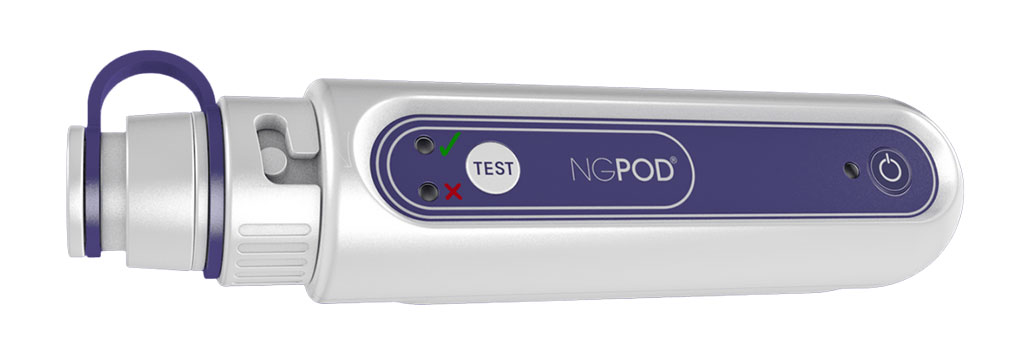Handheld Device Uses Fiber Optic Sensor to Determine Correct Nasogastric Feeding Tube Placement 
|
By HospiMedica International staff writers Posted on 17 Jul 2023 |

Annually, nurses are tasked with inserting over a million feeding tubes into patients' stomachs for the delivery of nutrition, hydration, and medication. It is reported that inaccurate placement of nasogastric tubes (NGTs) occurs in 1-3% of all insertions, which can lead to severe consequences including treatment delays and, in some cases, death. The majority of NGTs are inserted 'blind', as the procedure does not involve any form of visualization to confirm correct positioning before use. Traditional methods, in use for the past 20 years, are inherently flawed. The first technique to confirm NGT placement involves pH testing of the NGT aspirate. If a pH level of 5.5 or lower is achieved, the NGT is deemed safe, otherwise, chest X-rays are required. However, pH strips can fail in up to 45% of cases due to difficulty in obtaining aspirate, necessitating an X-ray for the patient and causing an average treatment delay of approximately eight hours. Now, a new electronic device specifically designed for correct NGT placement could eliminate the problem of incorrectly inserted feeding tubes.
NGPod Global (Cheshire, UK) has developed the NGPOD system, a device designed to tackle the risks associated with traditional nasogastric placement confirmation techniques. The portable NGPod device employs a fiber optic sensor that is introduced directly into the stomach via the feeding tube, eliminating the need for aspirate while transmitting light signals back to a handheld device. The NGPOD system also eliminates the need to aspirate gastric contents from the patient and reduces the risk of clinical interpretation errors by providing a safe bedside test that delivers a clear 'yes' or 'no' result. Furthermore, the device lowers the requirement for unnecessary X-rays to confirm placement, contributing to patient safety and cost-efficiency.
Using the product is straightforward and would require a maximum of 20 minutes for a professional to learn how to use the device with barriers set up in the device to prevent human errors. In a recent clinical trial consisting of 154 adult patients, researchers compared the performance of NGPod against the current pH strip procedures and found that it reduces the need for patients to use an X-ray by 61% while improving safety and human error. The device is currently in 12 hospitals in the UK with another eight scheduled to be implemented in the next six months.
Related Links:
NGPod Global
Latest Critical Care News
- Novel Cannula Delivery System Enables Targeted Delivery of Imaging Agents and Drugs
- Ingestible Smart Capsule for Chemical Sensing in the Gut Moves Closer to Market
- Novel Intrabronchial Method Delivers Cell Therapies in Critically Ill Patients on External Lung Support
- Generative AI Technology Detects Heart Disease Earlier Than Conventional Methods
- Wearable Technology Predicts Cardiovascular Risk by Continuously Monitoring Heart Rate Recovery
- Wearable Health Monitoring Device Measures Gases Emitted from and Absorbed by Skin
- Groundbreaking Technology Rapidly Detects Airborne Influenza Viruses
- Handheld Device Could Transform Heart Disease Screening
- Flexible Semi-Autonomous Robot Could Deliver Medicine Inside Body

- Neurorestorative Treatment Strategies Hold Promise for Most Severe Forms of Epilepsy
- Gene Discovery Could Help Grow New Heart Arteries
- Study Discovers Invisible Transmission of Common Hospital-Associated Infection
- Non-Invasive Neuro-Ophthalmology Techniques Could Detect Brain Tumors Earlier
- Mass Manufactured Nanoparticles to Deliver Cancer Drugs Directly to Tumors
- World’s Smallest Pacemaker Fits Inside Syringe Tip

- AI-Powered, Internet-Connected Medical Devices to Revolutionize Healthcare, Finds Study
Channels
Surgical Techniques
view channel
Pioneering Sutureless Coronary Bypass Technology to Eliminate Open-Chest Procedures
In patients with coronary artery disease, certain blood vessels may be narrowed or blocked, requiring a stent or a bypass (also known as diversion) to restore blood flow to the heart. Bypass surgeries... Read more
Intravascular Imaging for Guiding Stent Implantation Ensures Safer Stenting Procedures
Patients diagnosed with coronary artery disease, which is caused by plaque accumulation within the arteries leading to chest pain, shortness of breath, and potential heart attacks, frequently undergo percutaneous... Read more
World's First AI Surgical Guidance Platform Allows Surgeons to Measure Success in Real-Time
Surgeons have always faced challenges in measuring their progress toward surgical goals during procedures. Traditionally, obtaining measurements required stepping out of the sterile environment to perform... Read morePatient Care
view channel
Portable Biosensor Platform to Reduce Hospital-Acquired Infections
Approximately 4 million patients in the European Union acquire healthcare-associated infections (HAIs) or nosocomial infections each year, with around 37,000 deaths directly resulting from these infections,... Read moreFirst-Of-Its-Kind Portable Germicidal Light Technology Disinfects High-Touch Clinical Surfaces in Seconds
Reducing healthcare-acquired infections (HAIs) remains a pressing issue within global healthcare systems. In the United States alone, 1.7 million patients contract HAIs annually, leading to approximately... Read more
Surgical Capacity Optimization Solution Helps Hospitals Boost OR Utilization
An innovative solution has the capability to transform surgical capacity utilization by targeting the root cause of surgical block time inefficiencies. Fujitsu Limited’s (Tokyo, Japan) Surgical Capacity... Read more
Game-Changing Innovation in Surgical Instrument Sterilization Significantly Improves OR Throughput
A groundbreaking innovation enables hospitals to significantly improve instrument processing time and throughput in operating rooms (ORs) and sterile processing departments. Turbett Surgical, Inc.... Read moreHealth IT
view channel
Printable Molecule-Selective Nanoparticles Enable Mass Production of Wearable Biosensors
The future of medicine is likely to focus on the personalization of healthcare—understanding exactly what an individual requires and delivering the appropriate combination of nutrients, metabolites, and... Read more
Smartwatches Could Detect Congestive Heart Failure
Diagnosing congestive heart failure (CHF) typically requires expensive and time-consuming imaging techniques like echocardiography, also known as cardiac ultrasound. Previously, detecting CHF by analyzing... Read moreBusiness
view channel
Expanded Collaboration to Transform OR Technology Through AI and Automation
The expansion of an existing collaboration between three leading companies aims to develop artificial intelligence (AI)-driven solutions for smart operating rooms with sophisticated monitoring and automation.... Read more
















